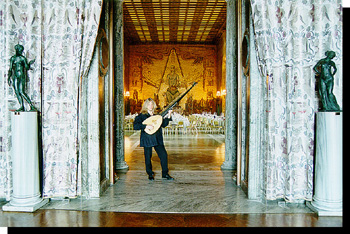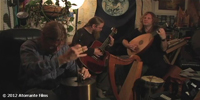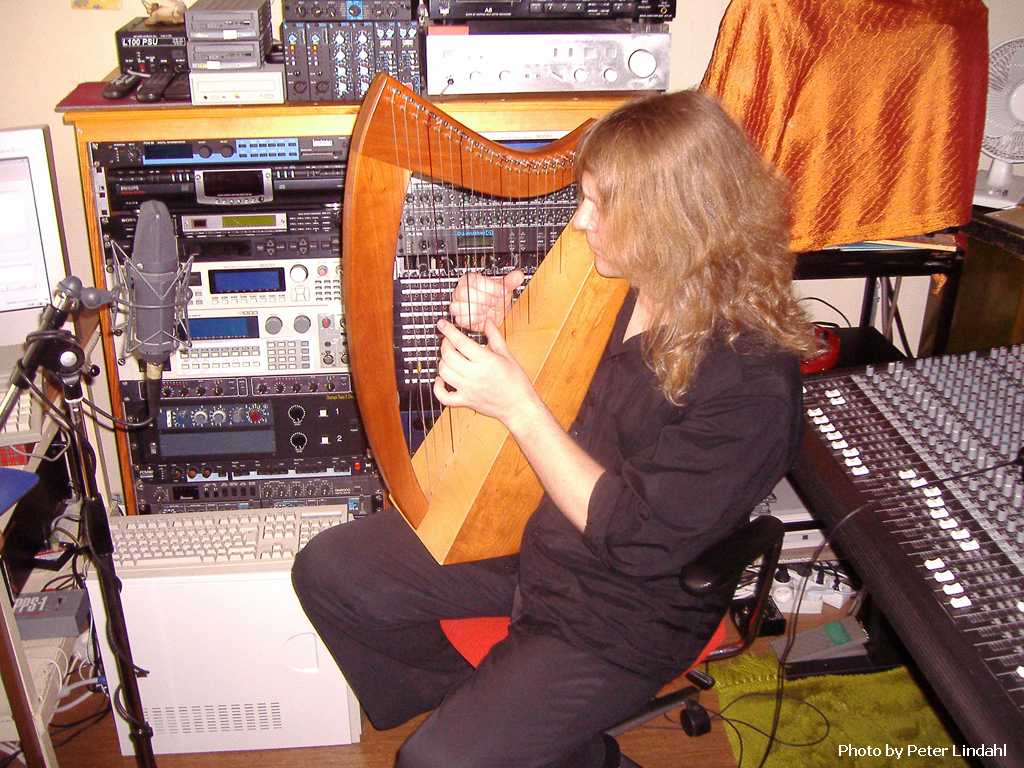Index

Baroque lute (13-course)
Baroque lute (11-course)
Renaissance lute (10-course)
Oud (5-course)
Electric guitar
Acoustic guitar
Ukuleles
Banjolele
Celtic harp (22-string)
Piano
Synthesizer
Robert Eklund’s Music Audio & Video Page |
I have only one regret: you should have played more! |
Uttered by
Harold Bloom
as a comment on my dinner performance |
These pages contain information about my musical activities and proclivities,
starting with the instruments I tend to play. Academic and other information
is arrived at by clicking on one of the buttons above.
Anyway, below you find sound and film clips of me playing some of my
instruments, including some of my own compositions. I intend to record something
on each and every instrument.
For more information on international recordings I appear on, see the
Discography Page.
For information on some of my instruments, see the
Miscellaneous Page.
For some information on the lute (my main instrument), see the
Lute Page.
For information on my musicological research, see the
Research Page.
|
Archlute |
The archlute was invented around 1580 in Italy, allegedly by the composer Alessandro Piccinini (1566–c.1639). It was used mainly as a continuo instrument, but solo music exists by e.g., Bernardino Gianoncelli (1650) and Giovanni Zamboni (c.1720). The instrument has normal Renaissance tuning, and normally has six or seven stopped courses, with an additional set of very long open bass strings. The number of courses are normally 14, but my instrument has fifteen courses, with lowest either tuned to a low D (ringing three semi-tones below the low E of an electric bass, given the 415 Hz Renaissance tuning), or an high F sharp, often useful in continuo playing. |

|
|
| Stockholm City Hall, July 1999. |
The following piece is a short, but lovely, prelude by Giovanni Zamboni, from his collection Sonate D’Intavolatura di Leuto. |
| Preludio by Giovanni Zamboni (c.1720). | [mp3] |

|
Film clip of a Chiaccona in partite variate by Alessandro Piccinini (1566–c.1638), from the book Intavolatura di Liuto, et di Chitarrone, Libro Primo (1623), p. 121. It’s actually written for a chittarrone, but works well on an archlute (methinks). Recorded in Västerhaninge Church, July 2002. |
[mpg] [real] [wmv] |
Extraits baroque |
During my years in Paris (France) I played on a regular basis with the fantastic singer Anne Pichard. We also teamed up with a cello player and formed the ensemble Extraits baroque. Since I have not been able to track down the (fabulous) cellist, I’m not revealing her name here, but if you happen to know about her whereabouts, please do tell me. Anne has since become even better, while my own playing has deteriorated, so I am grateful to Anne for allowing me to put a song here. Merci!! |

|
Église suédoise, Paris, 28 April 1989. |
| Se l’Aura spira by Girolamo Frescobaldi (1583–1643). | [mp3] |
Baroque lute, 13-course |
This type of instrument was used from around 1720 until c. 1760 (when most people had stopped playing the lute, anyway). If Johann Sebastian Bach actually wrote pieces for the lute (who knows?), this was the kind of instrument he had in mind. |

|
Häringe Slott (Castle), New Year’s Eve, 1995. |

|

|
Stockholm City Hall, July 1999. |
| Coming soon (practicing!). | [N/A] |
Baroque lute, 11-course |
This type of instrument was used from around 1630 until 1700. A lutenist I met said that the best marriage between an instrument type and a musical style ever is that of French baroque lute (solo) music and the 11-course baroque lute. (Another friend commented that the person who said that had never heard Chopin. I think they are both right.) Anyway, the style brisé which is typically played on this instrument is indeed very personal and special. |

|
Artwork by Robert Eklund. All similarities with other persons, especially dead, are intentional. Below two pieces are found, recorded on 8 May, 2005, in the In The Labyrinth Studio, Stockholm, Sweden. |
|
Sarabande by Jacques Bittner, from Suite in G minor (published 1682). http://www.youtube.com/watch?v=CSNFRO3BH3s |
[mp3] [mp4] |
|
L‘Amant malheureux, Allemande by Jacques Gallot (17th century). http://www.youtube.com/watch?v=X8HNOmdFmdY |
[mp3] [mp4] |
Renaissance lute |
The instrument I am playing here is a 1610ish Renaissance lute. It has 10 courses/19 strings. |

|
Performing at an inauguration reception, German Cultural Centre, Paris, 24 February 1989. |

|
Film clip of the 16th century hit Elslein, liebstes Elslein mein by Hans Neusiedler (1508–1563), from the book Ein Neugeordent Künstlich Lautenbuch (1536). Recorded in Västerhaninge Church, July 2002. |
[mpg] [real] [wmv] |

|
Film clip of A Scots Tune, taken from the Jane Pickeringe Manuscript (c.1616–c.1650). Recorded in Västerhaninge Church, July 2002. |
[mpg] [real] [wmv] |

|
Jamming with Michael Masley. and Michael Masley. during the shooting of the upcoming film Art Officially Favored. Filmed in 2006. Published by kind permission from director Martín Yernazian . |
Oud |
The oud (or ud) is in a way the ancestor of the western lute, and has been played in its present shape for more than a thousand years. The oud is different from the western lute(s)in that it is fretless (like a violin) and is played with a plectrum, historically with an eagle's feather. (There are other differences, as well.) In October 2004, Miriam Oldenburg asked me whether I would consider buying and oud to perform in her planned new group, and lo and behold and much to her surprise, a couple of weeks later I had purchased an instrument. |

|
Improvising in stylish environment, January 2005. |

|
Studio work in the In The Labyrinth studio, September 2008. |
| La Rosa (Sephardic song). | [mp3] |
| Palästinalied by Walther von der Vogelweide (c.1170–c.1230). | [mp3] |
Electric guitar |
This is not my main instrument, I must say, and I’ve never felt very comfortable with it. I’m much more a finger-picking guy. Nevertheless, here are two one-string (finger-tapping) pieces I wrote in the mid-80s, when such things were popular. |

|
Performing in the group Bränd Buss, Ultrahuset, Handen, 6 June 1982. |

|

|
“Jesus”, Lead Guitar, and Kapellmeister in Telia Research Christmas party performance, December 2000. |
Un luthiste goes heavy metal by Robert Eklund, to be played
on any instrument with at least one string and twelve frets. |
[mp3] |
Längtan (Yearning) by Robert Eklund, another
one-string, fretboard tapping, piece (with some additional
synth playing in the background). |
[mp3] |

|
Volume pedal solo (premix version) from the song Raudalin, to appear
on the coming In The Labyrinth album Samas Antaral. |
[mp3] |
Acoustic guitar |
I learned the guitar from a James Taylor (one of my deities!) song book, and I’d say that that is what I do best: JT-style finger picking. For obvious copyright reasons, I can’t put one of JT’s songs here, so we’ll see what I come up with, eventually. :-) |

|
Performing Swedish folk music at the International Fair, International Students House, London, 6 March 1987. |
| Älvadans (Elf Dance) by Robert Eklund. | [mp3] |
Ukuleles |
While contributing harp and ukulele parts to a In The Labyrinth Christmas song project, I grabbed the opportunity to record a little Christmas ditty for my own homepage, the 16th century Christmas Carol Ding Dong! Merrily On High (of French origin). Later I also recorded a “shred” version, for kicks. (It’s also part of the “ Ukulele Ding Dong Shred” piece further down). Note that my banjolele does not employ re-entrant tuning, but has low fourth string. |

|
Me in the In The Labyrinth studio, November 2006. |
Given this instrument’s lute-like sound – which is why I refer to it as my “lutelele” – and the fact that its stringing makes it tuned exactly as a renaissance guitar, I’ve also recorded three dances by Guillaume Morlaye, from the Second livre de chansons... (1553). In June 2009 I returned to the In The Labyrinth studio and to record some of the pieces I performed at the Swedish Ukulele Festival (see below), and while I was there I also recorded the Swedish folk tune Vårvindar friska [Brisk Winds of Spring], also found below. |
|
Ding Dong! Merrily On High |
[mp3] |
|
Ding Dong Upper Speed Limit |
[mp3] |
|
Gaillarde – Branle – Branle by Guillaume Morlaye (1553) |
[mp3] |
|
Vårvindar friska [ Brisk Winds of Spring, Swedish traditional ] |
[mp3] |
While shopping around for ukuleles I came across this extremely flat, tiny and cute Brüko ukulele (German). I just had to buy it! |

|
Me with my tiny and extremely flat black little Brüko ukulele (November 2006). |
A little later I came across the slightly bigger, yellow, f-hole ukulele, which proved to be very “fast”, i.e. you can play fast runs quite easily on it. So, I decided to record something using all four ukuleles, and the result is found below. The first solos are played on the yellow, f-hole, ukulele, while the final tapping section and the final (really fast) solo are played on the “lutelele” (see above). All ukuleles are used for chords, and the black one also appears in the second part, where three instruments echo the melody line. |

|
Me with four ukes, including the yellow “jazz” ukulele. Photo by Peter Lindahl (September 2007) in his studio. |
|
Ukulele Ding Dong Shred (Arrangement: Robert Eklund) http://www.youtube.com/watch?v=ZTOa2w5z-7M&feature=youtu.be |
[mp3] [mp4] |
On 30 May, 2009, I performed at the Swedish Ukulele Festival in Göteborg, before 3000 spectators. I used two different instruments, my “lutulele” for the Morlaye renaissance guitar suite found above, as well as the Swedish folk tune Vem kan segla förutan vind [Who Can Sail Without Wind] and the Scottish folk tune I wish I were where Helen lyes, and then used my semi-electric Applause ukulele (amplified) to do the hymn Det är en ros utsprungen [German: Es ist ein Ros entsprungen; English: Lo, how a rose e'er blooming], some fretboard tapping, and the Papua New Guinea hymn Yumi litimapim. The five pictures from the festival performance below are used by kind permission of John Croft and Marcus Lundberg, respectively. |
Plucking |
Talking |
Tapping |
Picking / singing |
Plucking |
A couple of weeks after the festival I decided to record some of the pieces I performed and went back to the In The Labyrinth studio. Below you find the pieces I wish I were where Helen lyes, the Swedish folk tune Vem kan segla förutan vind [Who can sail without wind], in normal and reverse version (for kicks), and the Papua New Guinea hymn Yumi litimapim (with lyrics in Tok Pisin). Studio photos by Peter Lindahl, as usual. |
Eagle ukulele |
Applause ukulele |
|
I Wish I Were Where Helen lies from Balcarre’s Lute Book (c. 1700) |
[mp3] |
|
Vem kan segla förutan vind [ Who Can Sail Without Wind, Swedish traditional ] |
[mp3] |
|
Vem kan segla förutan vind [ NB! Reverse version! ] |
[mp3] |
|
Yumi litimapim Hymn from Papua New Guinea, lyrics in
Tok Pisin http://www.youtube.com/watch?v=PSwCsbcoDoo&feature=youtu.be |
[mp3] [mp4] |
Banjolele |
Banjolele is the instrument George Formby made famous in his funny movies. (Although they all refer to the instrument as a ukulele, for some strange reason. Ukuleles have tiny guitar-shaped bodies.) The piece I am providing here is a piece I wrote shortly after having bought the instrument in the mid-70s. Caution! I am using a pick, rather than my fingers, which is not very purist. |

|
Strumming on my balcony, March 2001. |
|
Morning/Evening Strut by Robert Eklund. |
[mp3] |
Celtic harp |
My most recent acquisition is a 22-string diatonic Celtic harp which I purchased in the wonderful music store Lark In The Morning in San Francisco, after having looked for the “right” instrument for more than twenty years. I use it mainly for mediaeval or early Renaissance music (rather than Celtic music). |

|
Me playing the harp (Renaissance lute on the bed next to me) at ToneHenge, the head quarters of the Artist General (Michael Masley), Berkeley, CA. Photograph by super-shredder Mickey Huff. |
Palästinalied was an unplanned recording in the In The Labyrinth studio in Stockholm, Sweden. While sampling the harp for future ITL projects, a heavy drizzle (sic!) temporarily forced me and ITL primus motor, Peter Lindahl, to take a short break, during which we realised that rain would be the perfect backdrop to a harp solo. Voilà! |

|
Me in the In The Labyrinth studio, May 2006. |
| Ja nun hons by Richard Lionheart (Coeur-de-Leon) (1157–1199). | [mp3] |
| Palästinalied by Walther von der Vogelweide (c.1170–c.1230). | [mp3] |
| A Scot’s Tune from Jane Pickeringe’s Lute Book (c.1616–c.1650). | [mp3] |
Piano |
This is probably the second thing I decided to become: a pianist! (Astronomer was the first.) However, if you’re not already famous when you’re twelve or so, it’s way too late, so I dropped the idea. |

|
Picture by Miriam Oldenburg, Royal College of Music, Stockholm, April 2005. |
|
Coming soon. |
[N/A] |
Synthesizer |
Although I do possess one, I am not a synthesizer player. However, some pieces do sit well with the sound quality, and I did play the synth in a rock group when I was young. |

|
Playing the synthesizer in the rock group Rassel, 1982ish. |
|
Älvadans (Elf Dance) by Robert Eklund. |
[mp3] |
|
Renaissance Revisited by Robert Eklund. |
[mp3] |
|
|